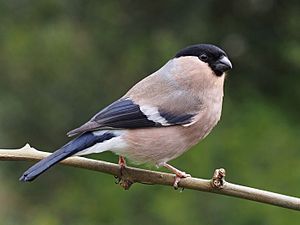List of species and habitats of principal importance in England facts for kids

England has special laws to protect its amazing wildlife. These laws make sure that lists are kept of the most important species and habitats (places where animals and plants live). Other parts of the UK, like Wales, Scotland, and Northern Ireland, have their own similar laws.
It's a legal duty for public groups, including local councils, to help protect biodiversity (all the different kinds of life) when they do their usual work. In England, this rule comes from a law called the Natural Environment and Rural Communities (NERC) Act 2006.
Contents
Choosing What's Important
The animals and plants chosen for these "principal importance" lists are those that are most at risk, have seen their numbers drop a lot, or where the UK has a large part of their total world population. Many of these lists first came from the UK Biodiversity Action Plan (UK BAP). The same goes for the important habitats in England.
These lists were checked in 2007. The total number of UK BAP habitats grew from 45 to 65. The number of UK BAP species also increased from under 600 to 1,150. For England specifically, the final list includes 56 of those 65 habitats and 943 of the 1,150 UK species.
Legal Rules for Protection
Section 40 of the Natural Environment and Rural Communities (NERC) Act 2006 makes it a legal requirement for public groups in England to care for specific animals and habitats that are most important for conservation. They also have a general duty to protect all biodiversity.
Section 41 of the same Act says that the Secretary of State must keep and share these official lists. This job is done by Defra and Natural England. These lists are sometimes called the 'Section 41 lists' or 'priority habitats' and 'priority species' lists.
Why These Lists Matter
Knowing if any of these important species or habitats are present is very important when local councils decide on new building projects. If these special animals or places are there, plans must be made to avoid or reduce any harm from new developments. By thinking about these things carefully, planning authorities show they are doing their part to protect biodiversity.
Important Habitats in England
The most recent update to the list of Section 41 habitats (also called priority habitats) was shared by Natural England in August 2010.
The list below shows the main type of habitat, then the specific important habitat name.
- Arable and horticulture: Arable field margins
- Arable and horticulture: Traditional orchards
- Boundary: Hedgerows
- Coastal: Coastal saltmarsh
- Coastal: Coastal sand dunes
- Coastal: Coastal vegetated shingle
- Coastal: Intertidal mudflats
- Coastal: Maritime cliff and slopes
- Coastal: Saline lagoons
- Freshwater: Aquifer-fed naturally fluctuating water bodies
- Freshwater: Eutrophic standing waters
- Freshwater: Mesotrophic lakes
- Freshwater: Oligotrophic and dystrophic lakes
- Freshwater: Ponds
- Freshwater: Rivers
- Grassland: Lowland calcareous grassland
- Grassland: Lowland dry acid grassland
- Grassland: Lowland meadows
- Grassland: Purple moor-grass and rush pastures
- Grassland: Upland calcareous grassland
- Grassland: Upland hay meadows
- Heathland: Lowland heathland
- Heathland: Mountain heaths and willow scrub
- Heathland: Upland heathland
- Inland rock: Calaminarian grasslands
- Inland rock: Inland rock outcrop and scree habitats
- Inland rock: Limestone pavements
- Inland rock: Open mosaic habitats on previously developed land
- Marine: Blue mussel beds
- Marine: Estuarine rocky habitats
- Marine: Fragile sponge and anthozoan communities on subtidal rocky habitats
- Marine: Horse mussel beds
- Marine: Intertidal boulder communities
- Marine: Intertidal chalk
- Marine: Maërl beds
- Marine: Mud habitats in deep water
- Marine: Peat and clay exposures
- Marine: Sabellaria alveolata reefs
- Marine: Sabellaria spinulosa reefs
- Marine: Seagrass beds
- Marine: Sheltered muddy gravels
- Marine: Subtidal chalk
- Marine: Subtidal sands and gravels
- Marine: Tide-swept channels
- Wetland: Blanket bog
- Wetland: Coastal and floodplain grazing marsh
- Wetland: Lowland fens
- Wetland: Lowland raised bog
- Wetland: Reedbeds
- Wetland: Upland flushes, fens and swamps
- Woodland: Lowland beech and yew woodland
- Woodland: Lowland mixed deciduous woodland
- Woodland: Upland mixed ashwoods
- Woodland: Upland oakwood
- Woodland: Wet woodland
- Woodland: Wood-pasture and parkland
Important Species in England
The most recent list of important species for conservation in England (priority species) was updated by Natural England in May 2014. It now includes 943 different species! This table shows some examples from each main group.

